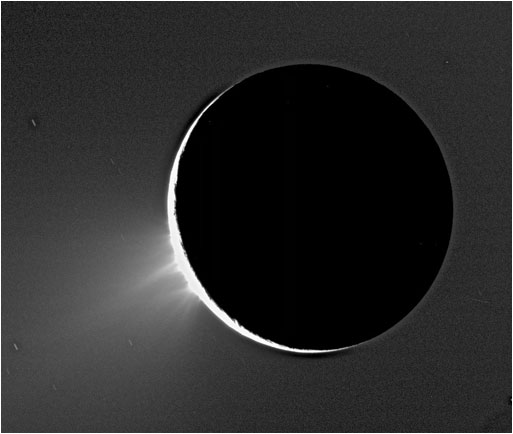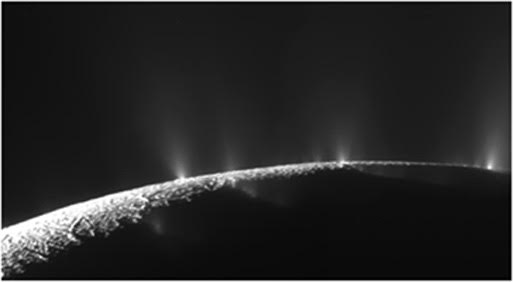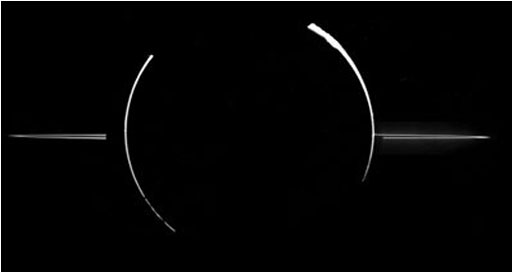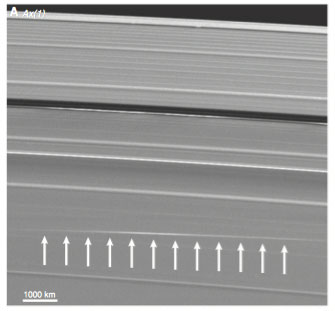
My address:
Prof Dr Juergen Schmidt
University of Oulu
Astronomy Research Unit
PL 3000
FI-90014 Oulu
Finland
jurgen.a.schmidt@oulu.fi
phone: +358 (0) 504 318 047
I am working as a professor in the Astronomy Research Unit of the University of Oulu. My main research interests are statistical physics and celestial mechanics applied to the dynamics of planetary rings and circumplanetary dust. I am Co-investigator of the Cosmic Dust Analyzer (CDA) instrument onboard the CASSINI (NASA/ESA) mission to Saturn, the Surface Dust Analyzer (SUDA) on the Europa Clipper Mission (NASA), and the JANUS camera onboard the ESA mission JUICE.
Solar System Research
One focus of research are small particles found in the environment of the planets of the solar system (circumplanetary dust).
These particles are usually smaller than one millimeter, often only a thousandth or a millionth of millimeter in size.
Such particles are widely distributed in the Solar system, often forming ring systems around the gas giants.
The grains can be created in a number of different processes. What makes them interesting to study is that they bear information from their points of origin,
like the surfaces or even the interiors of the moons of the giant planets. Also, because their motion is affected by the environment of the giant planets,
like the presence of magnetic fields or ions and neutral gas, we can learn about this environment from analysing the paths that these particles have taken.
Another motivation for the study of dust around the planets is spacecraft hazard: Impacts of larger particles tend to degrade the hardware of spacecraft
and in extreme cases may lead to fatal damage.
One example for dust research in Oulu is the Saturnian moon Enceladus (500km diameter).
The CASSINI (NASA/ESA) mission to Saturn
has discovered that Enceladus is active, expelling a plume of water vapor and tiny water ice particle from a system of cracks in the ice crust of the moon
around its south pole.

Credit: NASA/ESA/JPL

Credit: NASA/ESA/JPL
The instruments of the CASSINI spacecraft, which is at Saturn until late 2017, have studied Enceladus and its activity in detail.
The group in Oulu is involved directly in the science team of the Cosmic Dust Analyzer instrument, which is a detector especially designed for the study
of circumplanetary dust. The work characterized the number and sized of the ice grains
(Schmidt et al, 2008, Nature), but also
their chemical composition (Postberg et al, 2009,
Postberg et al, 2011, Nature).
This compositional information provided strong evidence that Enceladus harbors a reservoir of liquid water under its surface and the presence of a subsurface ocean
was confirmed later by other CASSINI instruments. Further compositional analysis carried out by the Cosmic Dust Analyzer team led to the conclusion on ongoing
hydrothermal activity inside Enceladus (Hsu et al, 2015, Nature),
possibly in a similar manner as it happens in some places in the deep sea on Earth. This finding bears strong implications for the habitability and the
astrobiological potential of the small icy moon Enceladus.
Another example for dust research in Oulu is the ESA funded project "Meteoroid Environment Model for the Jovian System" to assess the dust hazard for
ESA's future mission JUICE (JUpiter ICy moons Explorer). In the Jupiter system dust particles are created
when fast micro-meteoroids hit the surfaces of the numerous atmosphereless moons of Jupiter. These frequent impacts create small craters and part of the excavated
material is ejected into space. Such particles populate then the space around the path of their parent moon and they become visible as a dust ring in images
taken at special geometries.

Credit: NASA/ESA/JPL
The group in Oulu built a computer model of the Jovian micro-meteoroid environment. It was found that small dust particles form an egg-shaped ring that points towards the Sun,
while larger particles form an egg-shaped ring that points away from the Sun
(Liu et al, 2016, Journal of Geophysical Research).
Some of the particles can slowly change their plane of revolution around Jupiter, so that they eventually revolve even backward around the planet.
Part of our research results was covered as a
story on the page of
the American Geophysical Union (AGU).
We also took part in the investigation of the dust environment of Earth's moon. The analysis of data obtained by the
Lunar Dust Experiment (LDEX),
onboard the Lunar Atmosphere and Dust Environment Explorer (LADEE)
led to the detection of a permanent but variable dust cloud around the moon
(Horanyi et al, 2015, Nature).
Another focus of the planetary science group in Oulu are the rings of Saturn. The rings have attracted the attention of prominent researchers and amateur observers
in the last three and a half centuries. Today it is known that they consist of a large number of water ice boulders of 10cm to 10m in size. They were discovered by
Galileo Galilei and Huygens, Lagrange, Maxwell, and Henon have studied them. One motivation to do so is certainly the spectacular appearance of the Saturnian ring system
and the surprising richness of structure and dynamics that it exhibits.
Today we are also interested in understanding the rings because they allow to directly observe processes that were at work in a very similar manner in the early
days of the solar system, when the planets formed in a disk around the young Sun.
One example of research is the study of waves that are forming in the rings, manifesting themselves as ripples seen in images and other data taken from spacecraft.

Credit: NASA/ESA/JPL
One sort of waves emerges spontaneously from the motion of the ring matter around the planet, in a similar manner as certain waves are excited on the Earth's oceans by winds.
Another type of waves is created at certain locations in the rings as a response to the periodically recurring gravitational attraction of Saturnian moons,
revolving outside or inside the ring system. Recent work carried out in the group in Oulu
(Schmidt et al, 2016,
Lehmann et al, 2016, Astrophysical Journal)
addressed the way that these waves damp out when propagating away from the location where they are launched.
Other work, carried out in Oulu in the field of planetary rings, is the investigation of how the distribution of particle sizes has established
(Brilliantov et al., Proceedings of the National Academy of Sciences, 2015) and how impacts of meteoroids on the rings shatter ring particles,
leading to the observation of clouds of shattered material that spreads over the rings (Tiscareno et al, 2013, Science).

Credit: NASA/ESA/JPL , image taken from Tiscareno et al, 20013, Science
Collaborations/Projects
Awards:
NASA Group Achievement Award to the Cassini Cosmic Dust Analyzer Team 2009
Carl Ramsauer Preis 2002 of the Physikalische Gesellschaft zu Berlin
Publications
2016:
- M. Lehmann, J. Schmidt, H. Salo
-
A Weakly Nonlinear Model for the Damping of Resonantly Forced Density Waves in Dense Planetary Rings
Astrophysical Journal, 829
- J. Schmidt, J.E. Colwell, M. Lehmann, E.A. Marouf, H. Salo, F. Spahn, M.S. Tiscareno
-
On the Linear Damping Relation For Density Waves in Saturns Rings
Astrophysical Journal, 824
- X. Liu, M. Sachse, F. Spahn, J. Schmidt
-
Dynamics and distribution of Jovian dust ejected from the Galilean satellites
Journal of Geophysical Research, Planets, 121
- A.R. Dzhanoev, J. Schmidt, X. Liu, F. Spahn
-
Charging of small grains in a space plasma: Application to Jovian stream particles
Astronomy and Astrophysics, 591, A147
2015:
- M. Horanyi, J. Szalay, S. Kempf, J. Schmidt, E. Gruen, R. Srama, Z. Sternovsky
-
A permanent, asymmetric dust cloud around the Moon
-
Nature, 522, 324
- N.V. Brilliantov, P.L. Krapivsky, A. Bodrova, F. Spahn, H. Hayakawa, V. Stadnichuk, J. Schmidt
-
Size distribution of particles in Saturns rings from aggregation and fragmentation
-
Proceedings of the National Academy of Sciences, 112, 9536
- A.R. Dzhanoev, F. Spahn, V. Yaroshenko, H. Luhr, J. Schmidt
-
Secondary electron emission from surfaces with small structure
-
Physical Review B, 92, 125430
- F. Wiederschein, E. Voehringer-Martinez, A. Beinsen, F. Postberg, J. Schmidt, R. Srama, F. Stolz, H. Grubmueller, B. Abel
-
Charge Separation and Isolation in Strong Water Droplet Impacts
-
Physical Chemistry Chemical Physics, 17, 6858
- P. Meier, U. Motschmann, J. Schmidt, F. Spahn, T.W. Hill, Y. Dong, G.H. Jones, H. Kriegel
-
Modeling the total dust production of Enceladus from stochastic charge equilibrium and simulations
-
Planetary and Space Science, 119, 206
- M. Sachse, J. Schmidt, S. Kempf, F. Spahn
-
Correlation between speed and size for ejecta from hypervelocity impacts
-
Journal of Geophysical Research, Planets, 120
2014:
- P. Meier, H. Kriegel, U. Motschmann, J. Schmidt, F. Spahn, T.W. Hill, Y. Dong, G.H. Jones
-
A Model of the Spatial and Size Distribution of Enceladus Dust Plume
-
Planetary and Space Science, 104, 216
- G. Tobie et al.
-
The science goals and mission concept for a future exploration of Titan and Enceladus
-
Planetary and Space Science, 104, 59
- C.S. Arridge et al.
-
The science case for an orbital mission to Uranus: Exploring the origins and evolution of ice giant planets
-
Planetary and Space Science, 104, 122
2013:
- M. Tiscareno, C. Mitchell, C. Murray, D. Di Nino, M. Hedman, J. Schmidt, J. Burns, J. Cuzzi, C. Porco, K. Beurle, M. Evans
-
Observations of Ejecta Clouds Produced by Impacts onto Saturns Rings
-
Science, 340, 460
2012:
- A. Bodrova, J. Schmidt, F. Spahn, N. V. Brilliantov
-
Adhesion and collisional release of particles in dense planetary rings
-
Icarus doi:10.1016/j.icarus.2011.11.011
- S. Kempf, R. Srama, D. Gruen, A. Mocker, F. Postberg, J. Hillier, M. Horanyi, Z. Sternovsky, B. Abel, A. Beinsen, R. Thissen, J. Schmidt, F. Spahn, N. Altobelli
- Linear high resolution dust mass spectrometer for a mission to the Galilean satellites
-
Planetary and Space Science, 65, 10
- R. Srama et al.
- SARIM PLUS–sample return of comet 67P/CG and of interstellar matter
-
Experimental Astronomy, 33, 723
2011:
- F. Postberg, J. Schmidt, J. Hillier, S. Kempf, and R. Srama
-
A salt-water reservoir as the source of a compositionally stratified plume on Enceladus
-
Nature doi:10.1038/nature10175
- F. Postberg, E. Gruen, M. Horanyi, S. Kempf, H. Krueger, J. Schmidt, F. Spahn, R. Srama, Z. Sternovsky, M. Trieloff
-
Compositional mapping of planetary moons by mass spectrometry of dust ejecta
-
PSS 59, 1815
- S. Kempf, R. Srama, E. Gruen, A. Mocker, F. Postberg, J. Hillier, M. Horanyi, Z. Sternovsky, B. Abel, A. Beinsen, R. Thissen, J. Schmidt, F. Spahn, N. Altobelli
-
Linear high resolution dust mass spectrometer for a mission to the Galilean satellites
PSS doi:10.1016/j.pss.2011.12.019
- P. Schenk, D. P. Hamilton, R. E. Johnson, W. B. McKinnon, C. Paranicas, J. Schmidt, M. R. Showalter
-
Plasma, plumes and rings: Saturn system dynamics as recorded in global color patterns on its midsize icy satellites
-
Icarus doi:10.1016/j.icarus.2010.08.016
2010:
- M. Seiss, F. Spahn and Juergen Schmidt
-
Moonlet induced wakes in planetary rings: Analytical model including eccentric orbits of moon and ring particles
-
Icarus 210, 298-317
- J. N. Cuzzi, J. A. Burns, S. Charnoz, R. N. Clark, J. E. Colwell, L. Dones, L. W. Esposito, G. Filacchione, R. G. French, M. M. Hedman, S. Kempf, E. A. Marouf, C. D. Murray, P. D. Nicholson, C. C. Porco, J. Schmidt, M. R. Showalter, L. J. Spilker, J. N. Spitale, R. Srama, M. Sremcevic, M. S. Tiscareno, J. Weiss
-
An Evolving View of Saturn's Dynamic Rings
-
Science 327, 1470-1475
- S. Kempf, U. Beckmann, J. Schmidt
-
How the Enceladus Dust Plume Feeds Saturn's E ring
-
Icarus 206, 446-457
- H. Salo, J. Schmidt
-
N-body Simulations of Viscous Instability of Planetary Rings
-
Icarus 206, 390-409
2009:
- J. Schmidt, K. Ohtsuki, N. Rappaport, H. Salo, F. Spahn
-
Dynamics of Saturn's Dense Rings
-
Chapter 14 in Saturn from
Cassini, Springer, 2009, pp 413-458, Dougherty et al. Editors
- F. Postberg, S. Kempf, J. Schmidt, N. Brilliantov, A. Beinsen, B. Abel, U. Buck, R. Srama
-
Sodium Salts in E-Ring Ice Grains from an Ocean Below the Surface of Enceladus
- Nature 459, 1098-1101
- G. H. Jones, C. S. Arridge , A. J. Coates, G. R. Lewis, S. Kanani, A. Wellbrock, D. T.
Young, F. J. Crary, R. L. Tokar, R. J. Wilson, T. W. Hill, R. E. Johnson, D. G. Mitchell,
J. Schmidt, S. Kempf, U. Beckmann, C. T. Russell, Y. D. Jia, M. K. Dougherty, J. H.
Waite Jr., B. A. Magee
-
Fine Jet Structure of Electrically Charged Grains in Enceladus' Plume
-
Geophyscial Research Letters 36:L16204
- Shepelyansky, D.L., Pikovsky, A.S., Schmidt, J., and Spahn, F.
-
Synchronization mechanism of sharp edges in rings of Saturn.
-
Monthly Notices of the Royal Astronomical Society, 395:1934-1940
- Schmidt, J., Brilliantov, N. V.
-
Aggregation kinetics in a flow: The role of particle-wall collisions.
-
European Physical Journal, ST, 171:15-20
2008:
- Schmidt, J., Brilliantov, N. V., Spahn, F., and Kempf,
S.
-
Slow Dust in Enceladus' Plume from Condensation and Wall Collisions in Tiger Stripe Fractures
-
Nature, 451:685-688
- Marty, B. et al., Kronos: exploring the depths of Saturn with probes and remote sensing through an international mission
-
Experimental Astronomy
- Brilliantov, N.V., Schmidt, J., Spahn, F., Geysers of Enceladus: Quantitative analysis of qualitative models
-
Planetary and Space Science, 56:1596
2007:
- Sremcevic, M., Schmidt, J., Salo, H., Seiß, M.,
Spahn, F., and Albers, N.
-
A Belt of Moonlets in Saturn's A ring.
-
Nature, 449:1019-1021.
- Brilliantov, N. V., Schmidt, J., and Spahn, F.
-
Nucleation and Growth of a Solid Phase in a Gas Expanding into Vacuum.
-
Inter. J. Mod. Phys., 18:676-648
- Kempf, S., Beckmann, U., Moragas-Klostermeyer, G., Postberg, F., Srama, R. Economou, T., Schmidt, J., Spahn, F., and Gruen, E.
-
The E Ring in the Vicinity of Enceladus I: Spatial Distribution and Properties of the Ring Particles.
- Icarus
2006:
- Spahn, F., Albers, N., Hörning, M., Kempf, S., Krivov,
A. V., Makuch, M., Schmidt, J., Seiß, M., and Sremcevic,
M.
-
E Ring Dust Sources: Implications from Cassini's Dust Measurements.
-
Planetary and Space Science, 54:1024-1032.
- Spahn, F. and Schmidt, J.
-
Saturn's Bared Mini-Moons.
-
Nature, 440:614-615.
- Spahn, F., Schmidt, J., Albers, N., Hörning, M., Makuch,
M., Seiß, M., Kempf, S., Srama, R., Dikarev, V., Helfert, S.,
Moragas-Klostermeyer, G., Krivov, A. V., Sremcevic, M.,
Tuzzolino, A. J., Economou, T., and Grün, E.
-
Cassini Dust Measurements at Enceladus and Implications for the Origin of the E Ring.
-
Science, 311:1416-1418.
- Montbrio, E., Pazo, D., and Schmidt, J.
- Time Delay in the Kuramoto Model with Bimodal Frequency Distribution.
-
Physical Review E, 74: 056201
2005:
before 2004:
- Schmidt, J. and Salo, H.
-
A Weakly Nonlinear Model for Viscous Overstability in Saturn's Dense Rings.
-
Physical Review Letters, 90(6):061102.
- Gordon, M. K., Cuzzi, J. N., Lissauer, J. J., Poulet, F., Brahic, A.,
Charnoz, S., Ferrari, C., Burns, J. A., Nicholson, P. D., Durisen, R. H.,
Rappaport, N. J., Spilker, L. J., Yanamandra-Fisher, P., Bosh, A. S., Olkin,
C., Larson, S. M., Graps, A. L., Krueger, H., Black, G. J., Festou, M.,
Karjalainen, R., Salo, H. J., Murray, C. D., Showalter, M. R., Dones, L.,
Levison, H. F., Namouni, F., Araki, S., Lewis, M. C., Brooks, S., Colwell,
J. E., Esposito, L. W., Horanyi, M., Stewart, G. R., Krivov, A. V., Schmidt,
J., Spahn, F., Hamilton, D., Giuliatti-Winter, S., and French,
R. G.
-
Planetary rings.
In Sykes, M. V., Ed. , The Future of Solar-System Exploration,
p. 263-282. Univ. Arizona Press 2002.
- Hassan, M., Schmidt, J., Blasius, B., and Kurths, J.
-
Jamming and Asymptotic Behavior in Competitive Random Parking of Bidisperse
Cars.
-
Physica A, 315:163.
- Hassan, M., Schmidt, J., Blasius, B., and Kurths, J.
-
Jamming Coverage in Competitive Random Sequential Adsorption of a Binary
Mixture.
-
Physical Review E, 65(045107).
- Salo, H., Schmidt, J., and Spahn, F.
-
Viscous Overstability in Saturn's B Ring: I. Direct Simulations and
Measurement of Transport Coefficients.
-
Icarus, 153:295-315.
- Schmidt, J., Salo, H., Spahn, F., and Petzschmann, O.
-
Viscous Overstability in Saturn's B Ring: II. Hydrodynamic Theory and
Comparison to Simulations.
-
Icarus, 153:316-331.
- Spahn, F., Schmidt, J., Petzschmann, O., and Salo, H.
-
Stability Analysis of a Keplerian Disk of Granular Grains: Influence of
Thermal Diffusion.
-
Icarus, 145:657-660.
- Schmidt, J. and Kohler, C.
-
Torsion Degrees of Freedom in the Regge Calculus as Dislocations on the
Simplicial Lattice.
-
General Relativity and Gravitation, 33:1799-1807.
- Schmidt, J., Salo, H., Petzschmann, O., and Spahn,
F.
-
Vertical Distribution of Temperature and Density in a Planetary Ring.
-
Astronomy and Astrophysics, 345:646-652.
Conference Proceedings:
- Spahn, F., Petzschmann, O., Thiessenhusen, K.-U., and Schmidt,
J.
-
Inelastic Collisions in Planetary Rings: Thickness and Satellite-Induced
Structures.
-
In Physics of Dry Granular Media. Kluwer.
- Spahn, F., Schmidt, J., and Sremcevic, M.
-
Structures in Planetary Rings - Stability and Gravitational Scattering.
-
In Freund, J. and Pöschel, T., Ed. , Stochastic Processes in
Physics,Chemistry, and Biology, vol. 557 of Lecture Notes in
Physics. Springer.
- Spahn, F., Petzschmann, O., Schmidt, J., Sremcevic, M., and Hertzsch,
J.
-
Granular Viscosity, Planetary Rings and Inelastic Particle Collisions.
-
In Pöschel, T. and Luding, S., Ed. , Granular Gases.
Springer.
Invited Talks
- Jovian Meteoroid Environment Model JMEM: Dust from the Galilean Satellites, ESAC Madrid, 15 September 2016
- Dusty Plasma in the Saturn System, COSPAR 2016 Istanbul, 30 July - 7 August 2016 (the whole meeting was eventually canceled)
- Enceladus' Activity as revealed by Cassini Huygens}, August 2015, 29th General Assembly of the International Astronomical Union, Hawaii
- Plumes and Jets: Constraints on Vents and Eruption Dynamics from Observations and Models, December 2014, Fall Meeting of the American Geophysical Union
- Dynamics of planetary rings, Nonequilibrium Dynamics in Astrophysics and Material Science October 31 - November 3, 2011, Yukawa Institute, Kyoto, Japan
- Dynamics of Enceladus' Plume Particles and the Compositional Profile of the Plume, EPSC-DPS 2011 Nantes, 02-07 October 2011
- Saturns geheimnisvoller Eismond Enceladus, Lange Nacht der Wissenschaften Berlin-Potsdam, 18. Mai 2011
- Circumplanetary Dust Rings, COSPAR 2010 Bremen, 18-24 July 2010
- The Enceladus Dust Plume: Observations and Scenarios for Particle Formation, Dusty Visions Goettingen, 14-16 July 2010
- Cassini: Bei den Monden des Saturn, Lange Nacht der Wissenschaften Berlin-Potsdam, 5. Juni 2010
- How the Enceladus dust plume feeds Saturn's E ring, EGU Congress in Vienna, May 7 2010
- The Icy Breath of the Giant: Ice Particles from Saturn's Active Moon Enceladus, Max-Planck Institute for Dynamics and Self-Organization, Dynamics of Complex Fluids, Goettingen, April 22, 2010
- Die Staubringe der Gasriesen, Bruno H. Buergel Sternwarte Berlin, Feb 13, 2010
- Saturns geheimnisvoller Eismond Enceladus, Lange Nacht der Wissenschaften Berlin-Potsdam, 13. Juni 2009
- Saturns geheimnisvoller Eismond Enceladus, Urania Berlin, Jan 22, 2009
- Geysers and Plumes on Enceladus, 2nd ISSI-Europlanet Workshop `Moons of the Outer Solar System: Exchange Processes Involving the Interiors', Nov 17-27, 2008, Bern
- The Icy Breath of the Giant: Formation and Dynamics of Icy
Grains in Enceladus' Plume, University of Leicester, Nov 14 2008
- Propeller Structure Induced in Saturn's Rings by Embedded Moonlets, Nov 10, 2008, DAMTP Astrophysical Fluids Seminar, University of Cambridge, UK
- Saturn's Main Rings: A Dense Granular System, Conference "Granular Gases Beyond the Dilute Limit", Sept. 7-12, 2008, Bayreuth, Germany
- The Dynamics of Saturn's Dense Rings, Symposium Saturn After Cassini-Huygens, 28th July- 1st August 2008, Imperial College, London, UK
- Viscous Overstability in Saturn's Rings, 23rd July 2008, Laboratoire de Radioastronomie ENS, Paris
- Structure in Saturn's Rings: Modelling and Cassini Data, June 2008, Kolloquium of the SFB "Complex Systems" at the Fritz Haber Institute, Berlin
- The Formation of Enceladus' Dust Plume, June 2008, AOGS Meeting in Busan, Korea, Session "Outer Planets and Satellites with an Athmosphere"
- The Dynamics of Saturn's Dense Rings, January 2008, Saturn After Cassini-Huygens Meeting, Pasadena
- Modelling Cassini Data of Saturn's Rings, 15. January 2008, Nonlinear Dynamics Seminar, University of Bayreuth
- Cassini am Saturn, 14. Dez. 2007, Public Presentation at the Buergel Sternwarte, Berlin
- Moonlets Embedded in Saturn's Rings, 2007, Planetenseminar des Deutschen Luft und Raumfahrtzentrums, Adlershof, Berlin
- Cassini Dust Measurements at Enceladus, Okt. 2005, Department of Astronomy, University of Oulu, Finland
- Cassini CDA Dust Measurements at Enceladus, 09. Nov. 2005, Planetenseminar des Deutschen Luft und Raumfahrtzentrums, Adlershof, Berlin
Organization of Workshops and Conference Sessions
- AGU Fall Meeting 2013, San Francisco: Planetary Rings, Theory and Observation (with Linda Spilker and Larry Esposito)
- Dusty Visions, 17-19 July 2010, Stuttgart, (with H Krueger, R Srama, A Krabbe, C Engrand, S Green, E Gruen, H Kimura, S Kempf, M Trieloff, F Postberg, A Westphal, A Jaeckel, J Blum)
- AGU Fall Meeting 2012, San Francisco: Planetary Rings, Theory and Observation (with Linda Spilker and Larry Esposito)
- EPSC 2012, Madrid: Planetary Rings (with Martin Seiss and Frank Spahn)
- AGU Fall Meeting 2011, San Francisco: Planetary Rings, Theory and Observation (with Linda Spilker and Larry Esposito)
- EPSC-DPS 2011, Nantes: Planetary Rings (with Josh Colwell, Frank Spahn, and Matthew Tiscareno)
- 5th European Planetary Science Congress 2010, Rome: Enceladus (with Frank Postberg and Athena Coustenis)
- 5th European Planetary Science Congress 2010, Rome: Planetary Rings (with Frank Spahn)
- Dusty Visions, 14-16 July 2010, Goettingen, (with H Krueger, J Blum, C Engrand, S Green, A Graps, E Gruen, M Horanyi, A Krivov, R Srama, M Trieloff)
- ISSI Team: Enceladus As an Active Moon 2009-2010 in Bern (with Sascha Kempf)
- 4th European Planetary Science Congress 2009, Potsdam: Planetary Rings (with Frank Spahn)
- 6th meeting of the AOGS 2009 in Singapore: Satellites, Rings and Icy Dwarf Planets in the Outer Solar System (with Jun Kimura, Athena Coustenis, Steve Vance, and Hauke Hussmann)
- The Enigma of Enceladus: Observation and Modeling 2009 in Leicester, Uk (with Nicolai V. Brilliantov)
- 3rd European Planetary Science Congress 2008, Muenster: Planetary Rings (with Frank Spahn)
- 5th meeting of the AOGS 2008 in Busan: Satellites and Rings in the Outer Solar System (with Hauke Hussmann, Athena Coustenis, Jun Kimura, Steve Vance)
- 2nd European Planetary Science Congress 2007, Potsdam: The Enceladus Plume and Solar System Dust Rings (with Frank Spahn)
- 2nd European Planetary Science Congress 2007, Potsdam: Dense Planetary Rings (with Frank Spahn)
- 4th meeting of the AOGS 2007 in Bankog: Satellites, Rings, and icy Dwarf Planets in the Outer Solar System (with Hauke Hussmann, Athena Coustenis, Jun Kimura, Frank Sohl)
- 3rd meeting of the AOGS 2006 in Singapore: Satellites and Rings in the Outer Solar System (with Frank Sohl, Hauke Hussmann, Athena Coustenis)
- 1st European Planetary Science Congress 2006, Berlin: Planetary Rings - Formation and Structures (with Frank Spahn)
- Supercomputing in Climate Research (2nd Helmholtz Summer School 2002)
- Tools to Simulate Turbulence (1st Helmholtz Summer School 2001 in Potsdam)
|





